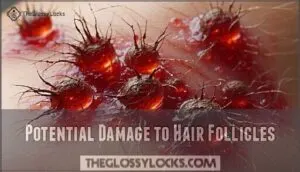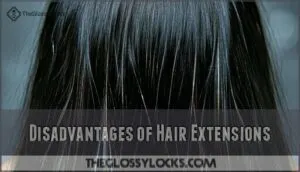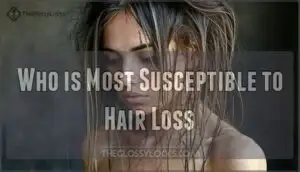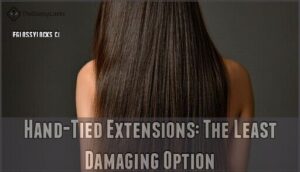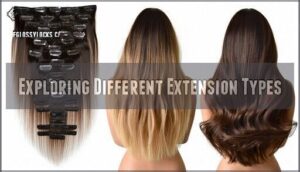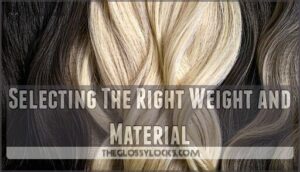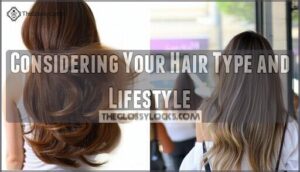This site is supported by our readers. We may earn a commission, at no cost to you, if you purchase through links.
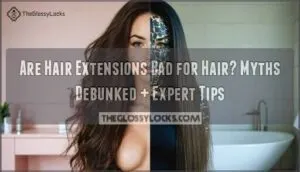
Think of it like wearing heels: done right, no problem, but poor choices can leave you hobbling.
The truth is, clip-ins and halos are your safest bet since they don’t require glue or heat.
However, if you’re constantly tugging, using harsh chemicals, or skipping proper care, you’re asking for trouble.
Your hair type, the extension quality, and application method all play starring roles in this drama.
The secret lies in knowing which type suits your lifestyle and how to care for both your natural hair and extensions properly.
Table Of Contents
- Key Takeaways
- Separating Fact From Fiction
- The Risks and Drawbacks
- Choosing The Right Type
- Caring for Your Extensions
- Maximizing The Benefits
- Frequently Asked Questions (FAQs)
- Are hair extensions bad for your hair?
- Do hair extensions damage follicles?
- Should you wear your hair extensions for too long?
- Do keratin hair extensions damage your hair?
- Do hair extensions damage your natural locks?
- Are hair extensions a fear?
- Can hair extensions ruin your hair?
- What is the least damaging hair extension?
- Is there a downside to hair extensions?
- Can you get a brain MRI with hair extensions?
- Conclusion
Key Takeaways
- Hair extensions aren’t inherently damaging – You’ll avoid problems by choosing quality extensions, getting professional application, and following proper care routines rather than cutting corners with cheap products or DIY installation.
- Choose the right type for your hair – You’ll minimize risks by selecting clip-ins or halos for temporary wear, hand-tied extensions for gentler long-term options, and matching extension weight to your natural hair’s strength and thickness.
- Professional application and maintenance are crucial – You’ll prevent traction alopecia and breakage by working with skilled stylists who place extensions properly and scheduling regular touch-ups every 6-8 weeks to maintain healthy attachment points.
- Proper daily care extends lifespan and prevents damage – You’ll keep both your natural hair and extensions healthy by using sulfate-free products, gentle brushing techniques, heat protection, and following specific maintenance routines designed for extensions.
Separating Fact From Fiction
You’ve probably heard horror stories about extensions ruining hair, but here’s the truth: most of these tales come from poor application or cheap products, not the extensions themselves.
Don’t let scare stories fool you—quality extensions with proper care are your hair’s best friend, not its enemy.
Let’s cut through the drama and look at what really happens when you choose quality extensions and work with a skilled stylist who knows their stuff.
Debunking The Myth of Damage
You’ve probably heard horror stories about hair extensions damage, but here’s the truth: most extension myths stem from poor application or cheap products.
Hair damage and hair breakage aren’t inevitable when you follow safe practices.
Professional advice emphasizes that quality extensions, proper installation, and regular maintenance protect your hair health.
The real hair extension damage risks come from cutting corners, not from extensions themselves.
Common Misconceptions About Hair Extensions
You’ve probably heard extension myths like "they’ll ruin your hair forever" or "you need breaks between applications."
These hair extension misconceptions create unnecessary fear.
The truth? Hair extension damage risks are largely avoidable with proper care.
Extensions are not inherently bad—DIY dangers and cheap products cause problems.
Quality materials plus professional advice protect your hair health and boost extension longevity.
Real-Life Experiences With Hair Extensions
Your hair extensions experience isn’t just about looks—it’s deeply personal.
Your hair journey becomes a reflection of your inner confidence and self-discovery.
Real stories reveal a complex relationship between extension confidence and self-image.
- Secret keeping becomes exhausting, hiding your "fake" hair from friends.
- Daily styling routines extend by hours, creating morning stress.
- Extensions become a crutch or benefit depending on your mindset.
- Embracing natural hair often happens after years of dependency.
Understanding these hair extensions personal stories helps you navigate potential hair extensions and insecurities while protecting against hair extensions damage.
The Importance of Proper Application
Imagine this scenario: your stylist’s hands work like magic, placing each extension strand with precision. Professional installation makes all the difference between gorgeous hair and a hot mess. Proper application prevents damage while ensuring seamless blending with your natural locks.
Color correction may be needed if the extensions clash with your natural hair, but can be addressed with toner application techniques.
| Application Factor | Poor Technique | Professional Method |
|---|---|---|
| Placement | Random positioning | Strategic strand placement |
| Tension | Excessive pulling | Gentle, even distribution |
| Blending | Obvious lines | Natural integration |
| Tools | Basic clips | Professional-grade equipment |
| Results | Damage risk | Extension longevity |
Avoiding damage starts with choosing trained professionals who understand hair extension installation methods.
The Risks and Drawbacks
Look, we’ve talked about the myths, but let’s be real—extensions aren’t always sunshine and perfect hair days, and you deserve to know what could go wrong.
While they’re generally safe when done right, there are some genuine risks that deserve your attention, especially if you’ve got fine hair or you’re prone to pulling at your strands when you’re stressed, which can lead to genuine problems.
Potential Damage to Hair Follicles
Extensions can seriously impact your hair follicles when things go wrong. Traction alopecia develops from constant pulling, while follicle scarring can cause permanent hair loss.
Here’s what puts your follicles at risk:
- Extension weight that’s too heavy for your natural hair
- Improper removal techniques that yank and tear
- Prolonged tension from tight applications
If you’re experiencing extensions hair loss, consider hair loss treatment options immediately.
Disadvantages of Hair Extensions
Beyond follicle damage, you’ll face real disadvantages with extensions.
Cost considerations hit hard – expect $500-2000 upfront plus ongoing maintenance. They’re high maintenance, demanding hours weekly for proper care.
Scalp irritation from constant weight creates discomfort, while traction alopecia remains a serious risk.
Many develop emotional dependence, feeling incomplete without them.
Extensions and breakage go hand-in-hand when poorly maintained, and hair extensions damage accumulates over time, making these hair extensions cons worth serious consideration.
Who is Most Susceptible to Hair Loss
Some people are like delicate flowers in the context of hair extensions damage – they need extra protection to thrive.
Your genetics and health history determine whether you’re more vulnerable to hair loss from extensions.
Thin Hair Types face the biggest challenges since fine strands can’t handle much weight or tension.
Hormonal Imbalances and Autoimmune Conditions weaken your hair’s natural defenses, making extensions and breakage more likely.
Stress Factors and Age-Related Changes also increase your risk.
A deficiency in key nutrients can also contribute to hair loss, so maintaining sufficient vitamin D levels is essential.
- Fine or naturally sparse hair breaks easier under extension weight
- Hormonal shifts during menopause or thyroid issues compromise hair strength
- High stress levels accelerate hair thinning and make follicles more fragile
How to Minimize Risks
In the context of hair extension safety, prevention beats damage repair every time.
Choose a stylist who specializes in professional application and commit to regular maintenance appointments.
Practice gentle handling during styling and select appropriate extension weight for your hair type.
Following healthy hair practices makes hair extension risks avoidable.
| Prevention Strategy | Frequency | Benefit |
|---|---|---|
| Professional maintenance | Every 6-8 weeks | Prevents damage buildup |
| Gentle brushing | Daily | Reduces breakage risk |
| Weight assessment | At installation | Matches hair strength |
Choosing The Right Type
You’ve heard the horror stories, but here’s the truth: picking the right extension type can mean the difference between gorgeous, healthy hair and a potential disaster waiting to happen.
Think of it like choosing the perfect pair of shoes – you wouldn’t wear stilettos for a marathon, and you shouldn’t pick heavy fusion extensions if you’ve got fine, delicate strands that barely survive your daily brush routine, which is a matter of choosing the right extension type for your specific hair needs, to avoid a potential disaster.
Hand-Tied Extensions: The Least Damaging Option
Gentle application means hand-tied wefts won’t leave you pulling your hair out—literally.
These featherweight champions use zero glue, tape, or heat during proper installation, making them your scalp’s best friend.
Hand-tied benefits shine through their thoughtful design:
- No chemical irritation from harsh adhesives damaging your precious strands
- Perfect weight distribution prevents those dreaded tension headaches
- Seamless blending makes detection nearly impossible, even on windy days
Professional maintenance tips guarantee your investment stays healthy while preventing hair extension damage through gentle care.
Exploring Different Extension Types
Your hair extension journey starts with picking the right type for your lifestyle. Clip-ins offer temporary glamour without commitment, perfect for special occasions. Tape-ins provide semi-permanent solutions with gentle application. Sew-ins create long-lasting results but need regular maintenance.
| Extension Type | Application Method | Duration | Best For |
|---|---|---|---|
| Clip-in | Temporary clips | Hours | Special events |
| Tape-in | Adhesive strips | 6-8 weeks | Daily wear |
| Sew-in | Cornrow braiding | 2-3 months | Thick hair |
| Glue-in | Keratin bonds | 3-4 months | Fine hair |
Remy hair extensions offer superior quality since cuticles remain intact, preventing tangling. You can find a variety of options when you shop clip in extensions. Understanding hair extension methods helps you avoid hair extension damage through proper selection and hair extension removal.
Selecting The Right Weight and Material
Choosing the right hair extension weight matters more than you’d think.
Fine hair needs 100-150 grams max, while thicker hair handles up to 200 grams without stress.
Remy vs. synthetic isn’t even close—human hair wins for durability and natural movement.
Quality material quality prevents hair damage down the road.
Match extension density to your natural texture for seamless blending that won’t cause breakage.
Considering Your Hair Type and Lifestyle
In the context of hair extension types, your hair type and lifestyle compatibility matter more than you think.
Fine hair needs lightweight options to prevent hair damage, while thick hair can handle heavier extensions.
Your daily routine determines your extension maintenance needs too.
Consider these emotional benefits:
- Freedom to wake up with perfect hair every morning
- Confidence knowing your extensions won’t fail during important moments
- Peace of mind from choosing extensions that work with your hair lifestyle
Professional consultation helps match hair type suitability with budget considerations for lasting results.
Caring for Your Extensions
You’ve invested in gorgeous extensions, but now comes the real test – keeping them looking salon-fresh without turning your hair routine into a three-hour marathon.
The truth is, proper extension care isn’t rocket science, but it does require some tweaks to your usual habits and a bit more TLC than your natural hair alone.
Recommended Hair Care Products
Looking after your extensions doesn’t require rocket science, but the right hair care products make all the difference.
Sulfate-free shampoos like Virtue Labs or OGX protect your investment without stripping natural oils. Pair with hydrating conditioners infused with keratin or hyaluronic acid. Heat protectants prevent damage, while detangling brushes designed for extensions keep knots at bay.
Many people seek gentle cleansing options for their hair.
| Product Type | Top Recommendations |
|---|---|
| Shampoo | Virtue Labs, Amika Hydro Rush, OGX Sulfate-Free |
| Conditioner | Moisture Restore, Color Security, Tarti |
| Heat Protection | Kerastase Oil Serum, Iles Formula Serum |
| Detangling | Keratin Protein Spray, Ghd Oval Brush |
| Styling | Money Mist Leave-in, Amika Water Sign Oil |
Drying and Styling Your Extensions
Proper drying and styling techniques can make the difference between gorgeous, long-lasting extensions and a hot mess. Heat styling wreaks havoc on extensions, so embrace air drying whenever possible – your wallet and hair will thank you.
When you must use styling tools, choose lower temperatures and quality hair extension dryers to prevent hair damage. Smart product choices protect against hair breakage while maintaining extension longevity.
Remember, gentle hair styling keeps your investment looking salon-fresh longer. Consider using products designed for frizz-free locks to maintain your extensions.
Here are three key tips
Preventing Tangling and Matting
Despite your best efforts, tangled extensions can turn your dream hair into a nightmare. Smart detangling techniques and proper brush selection make all the difference in preventing hair breakage.
Essential nighttime protection strategies:
- Braid loosely before bed to minimize friction
- Use silk scrunchies instead of tight elastics
- Apply leave-in conditioner for moisture retention
Your hair extensions deserve gentle care. Using the right products for detangling your extensions is vital for their longevity.
Regular Maintenance for Long-Lasting Extensions
Since proper hair extension maintenance can make or break your investment, let’s explore the essentials.
Your extensions need consistent TLC to stay gorgeous and protect your natural hair. Think of it as nurturing a friendship – ignore it, and things get messy fast.
Here’s your hair extension maintenance roadmap:
- Washing Frequency: Cleanse every 7-10 days with sulfate-free products
- Detangling Techniques: Use loop brushes twice daily, starting from ends
- Professional Adjustments: Schedule touch-ups every 6-8 weeks for peak scalp health
- Product Selection: Choose extension-specific formulas for best results
Maximizing The Benefits
You’ve done the hard work of choosing quality extensions and learning proper care, so now it’s time to enjoy the gorgeous results you’ve been dreaming about.
With the right approach, you’ll transform your hair game while keeping your natural strands healthy and happy.
Achieving Desired Length and Thickness
Extensions instantly give you that hair length and hair volume you’ve been dreaming about. Whether you want flowing locks or fuller thickness, the right extension materials and hair extension weight make all the difference.
Your stylist will focus on blending extensions seamlessly with your natural hair growth pattern during extension application. With proper extension maintenance, you’ll achieve stunning results without compromising your natural strands. It’s like having a hair transformation overnight.
Understanding your current hair length is key, which is explained in a hair length chart guide.
Boosting Confidence and Self-Esteem
Beyond the mirror’s reflection, hair extensions offer something deeper—a transformation in how you see yourself.
When your hair confidence soars, your entire self-perception shifts positively, creating ripples throughout your social acceptance and daily interactions.
This self-love journey isn’t just about vanity; it’s about reclaiming your inner beauty:
- Enhanced body image through improved physical appearance
- Boosted self-confidence in professional and social settings
- Stronger self-image that radiates from within
- Greater social comfort when meeting new people.
Your hair extensions become catalysts for genuine self-esteem growth.
Styling Options and Versatility
Your styling playground just expanded dramatically with hair extensions! Transform boring Tuesday hair into weekend-worthy waves or sleek office-ready ponytails.
Heat styling works beautifully on quality extensions, while braiding options multiply with added length. Extension textures blend seamlessly for natural looks, and updos and extensions create red-carpet drama.
| Style Category | Popular Options |
|---|---|
| Casual Looks | Beach waves, loose curls |
| Professional | Sleek ponytails, low buns |
| Special Events | Braided crowns, elegant updos |
| Textured Styles | Crimped looks, twist-outs |
Making The Most of Your Hair Extensions
Perfect styling techniques reveal your hair extensions’ full potential.
Create a maintenance schedule that keeps your investment looking salon-fresh for months.
Regular upkeep prevents hair extension damage and guarantees proper removal when it’s time.
You’ll discover versatile looks that boost your confidence daily – from sleek ponytails to beachy waves.
Here’s how to maximize your extension longevity:
- Schedule professional touch-ups every 6-8 weeks to maintain seamless blends
- Rotate styling patterns to prevent stress on specific attachment points
- Document your favorite looks with photos for easy recreation
Smart hair extension maintenance transforms temporary enhancement into long-term hair extension benefits.
Frequently Asked Questions (FAQs)
Are hair extensions bad for your hair?
You won’t damage your hair if you choose quality extensions and have them professionally applied.
The key is proper maintenance, rotating placement, and avoiding excessive tension that could lead to breakage.
Do hair extensions damage follicles?
Think your follicles are tough cookies?
Extensions can damage them if you’re not careful.
Excessive tension from heavy or poorly applied extensions causes traction alopecia, potentially scarring follicles permanently.
Choose wisely, maintain properly.
Should you wear your hair extensions for too long?
Keeping extensions in too long creates tension buildup that damages your roots and leads to breakage.
You should replace them every six to eight weeks to prevent traction alopecia and maintain healthy hair.
Do keratin hair extensions damage your hair?
Keratin extensions won’t wreck your hair if you’re smart about it. They’re actually gentler than sewn-in types since they distribute weight better. Just don’t skimp on professional application and maintenance.
Do hair extensions damage your natural locks?
Properly placed pieces won’t permanently harm your hair when you’re working with a skilled stylist.
However, heavy extensions or poor application can cause breakage and traction alopecia, so choose wisely and maintain regularly.
Are hair extensions a fear?
Hair extensions shouldn’t scare you, but they deserve respect.
You’re right to feel cautious—poor application or maintenance can damage your natural hair.
Choose experienced stylists, follow proper care routines, and listen to your hair’s needs.
Can hair extensions ruin your hair?
Yes, extensions can damage your hair if applied incorrectly or left too long.
They may cause traction alopecia, breakage, and thinning.
However, professional application and proper maintenance substantially reduce these risks for most people.
What is the least damaging hair extension?
Clip-in extensions are your safest bet since you control when they’re in.
They distribute weight evenly and won’t tug constantly at your roots like sewn-in methods, giving your natural hair breathing room.
Is there a downside to hair extensions?
Several downsides exist with extensions.
You’ll face potential traction alopecia, scalp irritation, and breakage if they’re improperly applied.
They’re time-consuming, expensive to maintain, and can become a psychological crutch masking natural beauty insecurities.
Can you get a brain MRI with hair extensions?
Metal components in some extensions can absolutely interfere with MRI machines, creating serious safety risks.
You’ll need to remove all extensions before your scan – no exceptions. Your technician will guide you through this process safely.
Conclusion
Like finding the perfect pair of jeans, discovering whether hair extensions are bad for hair comes down to fit, quality, and care.
You’ve learned that extensions aren’t villains when chosen wisely and maintained properly. Clip-ins and halos offer safer options, while proper application prevents damage.
Your hair type matters, quality counts, and gentle care keeps both your natural locks and extensions healthy.
With the right approach, you can enjoy gorgeous hair without the horror stories.

